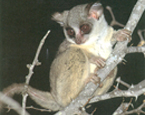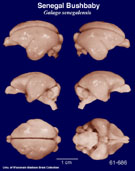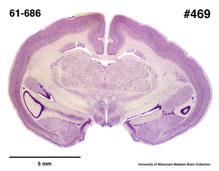|
Senegal
Bushbaby
(Galago senegalensis) #61-686 |
||||
|
|
Physical
characteristics and distribution
|
|
Head
and body length of G. senegalensis is 120-200 mm, tail
length is 180-300 mm, and weights range between 125-300 grams.
The dense woolly fur is long and slightly wavy and is silvery
gray to brown with light underparts. There are four transverse
ridges on the ears, allowing the bushbaby to wrinkle them down
at the tips or the base independently. The long digits of all
four feet have disk like pads at each tip to aid with grasping
and climbing. With the exception of a sharp grooming claw on
each hind foot, the digits all have flattened nails. Females
have four pair of mammae. G. senegalensis is found in savannah and forest savannah zones from Senegal to Somalia, south to the Mwanza and Ankole districts on Lake Victoria. |
|
Description
of the brain
|
|
Animal
source and preparation
|
|
All
specimens collected followed the same preparation
and histological procedure.
|
Other Related Resources (websites and publications)
List of Specimens | Explore Collections | Brain Sections | Brain Evolution | Brain Development | Brain Circuitry | Brain Functions | Location and Use | Related Web Sites | Contact Us | Search MSU Database | Personnel | Home



